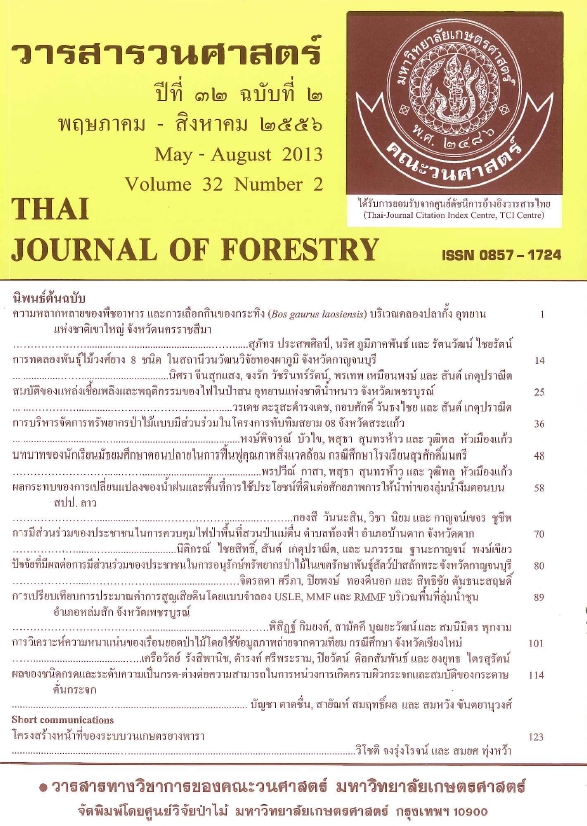โครงสร้างหน้าที่ของระบบวนเกษตรยางพารา
Main Article Content
บทคัดย่อ
การศึกษามีวัตถุประสงค์เพื่อค้นหาโครงสร้างหน้าที่ของระบบวนเกษตรยางพารา วิธีการศึกษาใช้การวิเคราะห์โครงสร้างหน้าที่โดยมีขั้นตอนคือ ทบทวนวรรณกรรม ลงพื้นที่สำรวจและสัมภาษณ์เกษตรกรที่ทำวนเกษตรยางพาราจำนวน 9 ราย คัดเลือกผู้ให้ข่าวสารสำคัญเข้าร่วมสนทนากลุ่มจำนวน 30 คน และวิเคราะห์ข้อมูล พบว่าโครงสร้างหน้าที่ของระบบวนเกษตรยางพารา มี 3 ประการ ได้แก่ 1) หน้าที่ด้านเศรษฐกิจ มีหน้าที่ย่อย 4 ประการ ประกอบด้วย การสร้างรายได้ที่หลากหลายและสม่ำเสมอ การเพิ่มประสิทธิภาพการผลิต การลดรายจ่ายของครัวเรือนเกษตรกร และการสร้างภูมิคุ้มกันทางเศรษฐกิจแก่ครัวเรือนเกษตรกร 2) หน้าที่ด้านสิ่งแวดล้อมและทรัพยากรธรรมชาติ มีหน้าที่ย่อย 8 ประการ ประกอบด้วยการอนุรักษ์ดิน บรรเทาการตื้นเขินของแหล่งน้ำ บรรเทาปัญหาน้ำท่วม บรรเทาภัยแล้ง ช่วยกำบังลมพายุ ช่วยฟอกอากาศ ลดภาวะโลกร้อน เพิ่มความหลากหลายทางชีวภาพ และ 3) หน้าที่ด้านความมั่นคงทางสังคม มีหน้าที่ย่อย 6 ประการ ประกอบด้วย ส่งเสริมการแบ่งปันผลผลิต ฟื้นฟูสุขภาพเกษตรกร เป็นแหล่งความรู้ ช่วยอนุรักษ์วัฒนธรรมท้องถิ่น ลดการบุกรุกป่าอนุรักษ์ และก่อให้เกิดการรวมกลุ่มทางสังคม โดยโครงสร้างหน้าที่ต่างๆ เหล่านี้ส่วนใหญ่มีความเชื่อมโยงและเกื้อกูลระหว่างกัน การศึกษานี้สอดคล้องกับผลการศึกษาของนักวิชาการทั้งไทยและต่างประเทศในประเด็นหน้าที่ด้านเศรษฐกิจ และทรัพยากรธรรมชาติและสิ่งแวดล้อม และการศึกษานี้แสดงให้เห็นถึงหน้าที่ด้านความมั่นคงทางสังคมของระบบวนเกษตรยางพาราด้วย ข้อค้นพบเหล่านี้ได้เปิดเผยคุณค่าที่ซ้อนเร้นของระบบวนเกษตรยางพาราซึ่งเป็นรูปแบบหนึ่งของระบบเกษตรกรรมยั่งยืนที่สร้างภูมิคุ้มกันต่อความเสี่ยงและความไม่แน่นอนของเศรษฐกิจโลกและการเปลี่ยนแปลงสภาพภูมิอากาศที่นับวันจะรุนแรงมากขึ้นเนื่องจากโครงสร้างหน้าที่ที่หลากหลายของระบบดังกล่าวซึ่งมีเหนือกว่าระบบการปลูกยางเชิงเดี่ยว
คำสำคัญ: โครงสร้างหน้าที่ ระบบวนเกษตรยางพารา ความเสี่ยงและความไม่แน่นอน
Downloads
Article Details

อนุญาตภายใต้เงื่อนไข Creative Commons Attribution-NonCommercial-NoDerivatives 4.0 International License.
ข้าพเจ้าและผู้เขียนร่วม (ถ้ามี) ขอรับรองว่า ต้นฉบับที่เสนอมานี้ยังไม่เคยได้รับการตีพิมพ์และไม่ได้อยู่ในระหว่างกระบวนการพิจารณาตีพิมพ์ลงในวารสารหรือสิ่งตีพิมพ์อื่นใด ข้าพเจ้าและผู้เขียนร่วม (ถ้ามี) ยอมรับหลักเกณฑ์และเงื่อนไขการพิจารณาต้นฉบับ ทั้งยินยอมให้กองบรรณาธิการมีสิทธิ์พิจารณาและตรวจแก้ต้นฉบับได้ตามที่เห็นสมควร พร้อมนี้ขอมอบลิขสิทธิ์ผลงานที่ได้รับการตีพิมพ์ให้แก่วารสารวนศาสตร์ คณะวนศาสตร์ มหาวิทยาลัยเกษตรศาสตร์ กรณีมีการฟ้องร้องเรื่องการละเมิดลิขสิทธิ์เกี่ยวกับภาพ กราฟ ข้อความส่วนใดส่วนหนึ่ง หรือ ข้อคิดเห็นที่ปรากฏในผลงาน ให้เป็นความรับผิดชอบของข้าพเจ้าและผู้เขียนร่วม (ถ้ามี) แต่เพียงฝ่ายเดียว และหากข้าพเจ้าและผู้เขียนร่วม (ถ้ามี) ประสงค์ถอนบทความในระหว่างกระบวนการพิจารณาของทางวารสาร ข้าพเจ้าและผู้เขียนร่วม (ถ้ามี) ยินดีรับผิดชอบค่าใช้จ่ายทั้งหมดที่เกิดขึ้นในกระบวนการพิจารณาบทความนั้น”


